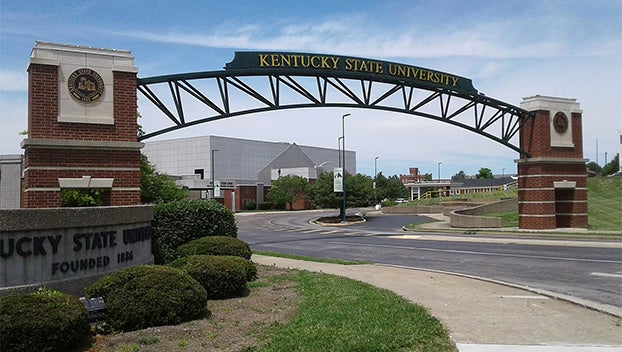Kentucky State University financial officer calls school’s financial woes ‘a $15 million problem’
Published 5:18 am Thursday, August 19, 2021
The financial problems facing Kentucky State University have made headlines for the past month.
At Wednesday’s KSU Board of Regents meeting newly hired Chief Financial Officer Greg Rush, who was sent from the Council on Postsecondary Education (CPE), presented some concrete financial figures to make sense of those headlines.
Major sources of concern include a more than $24 million negative swing in net position over five years, significant carryover expenses from last year’s budget to this year’s and an overall $10 to $15 million budget shortfall for this fiscal year.
“The bottom line is we had $15 million over expenses hitting this year’s budget,” Rush said. “We can’t budget cut our way out of this one. This is going to take a while to resolve and it’s going to take outside assistance to resolve, in my opinion.”
Board Chair Elaine Farris told reporters on Wednesday that she didn’t believe the board was responsible for the financial woes because it was not privy to the specifics of what Rush presented during Brown’s tenure.
“We did not receive (that information) from the president,” Farris said. “We did not receive those reports.”
The depth of the problem, Rush said, means that the solution will likely take more than a year.
In a lengthy presentation to the board, Rush said that expenses have exceeded the approved budget for the last three years, that the school owes $5.5 million to state accounts that manage its construction projects and that the school failed to pay some vendors.
The problem was so significant that KSU, with support from CPE which is leading a review into the school, had to get an advance of its fourth quarter state allotment. That allotment would have normally been made available to KSU on April 1 of next year.
Rush said that school’s cash position and assets vs. liabilities figures had taken a significant turn for the worse since 2016. Cash and cash equivalents have dropped from around $20 million to $4 million.
Assets vs. liabilities took a $30 million turn for the worse, per Rush’s figures.
In 2016, Rush said that KSU had around $26 million in assets and about $9 million in liabilities. In 2021, the assets shrunk to $6 million and the liabilities grew to $19 million.
Rush said that with only so many days into his new role, he could not fully explain what accounted for the increased spending by the school, and what put it into the dire position he described. He did note, though, that personnel costs have increased of late.
“I can’t tell you exactly why we’re in our position… but personnel expenditures have increased significantly from year to year,” Rush said.
Rush’s first slide emphasized that on July 21, one day after Brown’s resignation, the school had just $2.8 million cash on hand and $3 million outstanding bills.
Brown had just been awarded an extension to remain in his position until 2025 before his resignation, and was making more than $400,000.
About $18.5 million in unspent CARES funds was also a source of concern, but a portion of it is being used to extinguish students’ outstanding balances for tuition and fees from the onset of the COVID-19 pandemic to today.
Hidden figures
Rush told the board that a reduced pension impact was “masking” the school’s troubling numbers. He used the school’s change in net position from 2018 to 2019 to illustrate that point. The school’s net position, per the audit performed for that year, decreased by more than $2.8 million.
“All other things being equal, you should have seen from 2018 to 2019 an improvement in the university’s net position by about $10 million. What you actually see is a decline of about $2 million. The real operations of the university we’re being masked by the pension impact.”
Vice Chair Dalton Jantzen echoed Farris’ claim that the board was not aware of the extent of the financial troubles.
“I think things have been masked for us for some time,” Jantzen said. “I appreciate the candidness and the straightforwardness of the presentation.”
Farris said that when the board was made aware of the issues, it took “immediate action.”
“The board feels strongly that timely and appropriate information was not presented in the past to make informed decisions,” Farris said. “When the board received concrete information of financial concerns — verified information, the board took immediate action.”
Rush said that a big part of the problem that led to the “distorted” numbers was the amount of bills carried forward from one year to the next and the turnover in financial staff.
“Within the university’s financial statements, how expenditures are reflected in what account, I’m seeing a lot of inconsistency from year to year,” Rush said. “And also when you carry bills forward, even historic expenditure, which makes it very difficult to budget, it makes it difficult to see what happened in which year.”
Former Executive Vice President for Finance and Administration/CFO Douglas Allen left the university in June after three years in his role. Controller Casey Jo Lightfoot also resigned in June.
What’s next
Rush and CPE President Aaron Thompson, who provided an update on his office’s review into KSU, emphasized that figuring out the underlying problems with the school’s finances is an ongoing problem.
Regent Paul Harnice said that he was glad the school was hitting “reset,” on its financial situation, and commended Rush’s candor.
“I’ve always said it’s good to hear the good information, but what I want to hear is the bad news,” Harnice said. “What I need to be told is the bad news — not everything’s great and rosy. Tell us what the problems are so we can begin fixing them.”
Farris said that with the information Rush presented, the board is on a better footing to move forward.
“I appreciate all the work that’s taken place, and I think everybody on this campus has been a part of trying to uncover,” Farris said. “There will be more rocks to turnover. We don’t know exactly what else is out there. But this is a great start.”
Rush said that a hiring freeze, as well as a freeze on most salaries with some exceptions, has been implemented for now.
In a release from the school, Acting President Clara Ross Stamps, said that she appreciated the “clarity” gained by the financial presentation.
“The good news is that we are gaining clarity and understanding in regard to the financial health of Kentucky State University,” Stamps said. “Since its founding in 1886, this institution has navigated difficult times with resolve, discipline and dedication to serve Kentucky State’s education mission. We understand this is a lot to process and that we may well find additional unresolved items and issues.”






